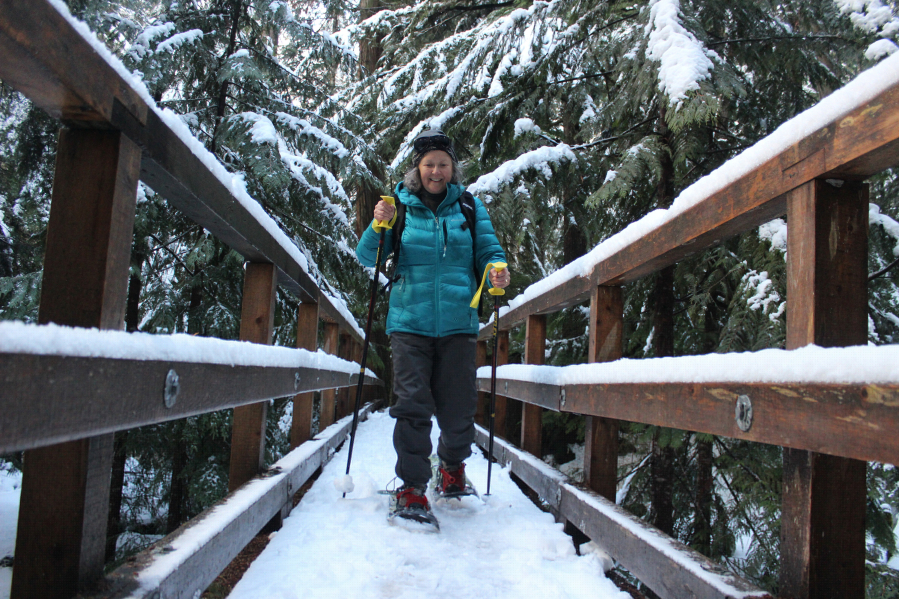MT. BAKER-SNOQUALMIE NATIONAL FOREST — Lumberjacks did their best to drag every prized specimen out of the forested slopes of the Cascades during the logging heyday there a century ago, but they missed a little patch along Humpback Creek just before it dumps into the South Fork Snoqualmie River.
That oversight is a winter hiker’s boon, one of several slices of woods now more easily available during the snowy months thanks to the new Annette Lake Sno-Park off Interstate 90 near Snoqualmie Pass.
While the Mountains to Sound Greenway trailhead just south of I-90 via exit 47 is a well-known summer and fall hiking destination — one with a recently spruced-up trail, no less — this season marks the first winter that the access road and trailhead parking lot are reliably plowed. You’ll need a nonmotorized Sno-Park permit ($25 per day, $50 per season; visit epermits.parks.wa.gov or Seattle-area outdoors retailers) to access the snowy park.
The half-mile from the interstate to the Sno-Park is rough going due to some crater-sized potholes. Drive carefully, but even low-clearance vehicles should be able to negotiate the otherwise flat stretch of asphalt. The reasonably roomy Sno-Park can accommodate 40 vehicles, give or take, and includes a restroom. Once you’re geared up with the 10 essentials, the Sno-Park offers two ways to explore winter in the Cascades.
The Asahel Curtis Nature Trail is a half-mile loop heading left from the trailhead and named for the legendary Seattle landscape photographer. There you’ll find those old-growth Doug firs, Western hemlocks and Western red cedars — hopefully boughs laden with snow — that Paul Bunyan and his ilk left standing.
Right out of the gate, the footbridge over Humpback Creek is a showstopper, as mountain-fresh snowmelt cascades over mossy rocks below. Tip your tuque (as Canadians call beanies) to the Washington Trails Association, whose volunteers moved some 200,000 pounds of dirt, rock and gravel in 2014 to create the trail up to the bridge. Along the loop you’ll encounter a series of plaques with facts and figures about the area’s natural history.
The Asahel Curtis Natural Trail makes for a soothing warm-up before venturing farther afield.
Angle right from the trailhead and you’ll find yourself on the Annette Lake Trail itself. Over the course of 0.8 miles and 500 vertical feet, you’ll cross Humpback Creek again on another footbridge, eventually reaching a clearing as the narrow singletrack Annette Lake Trail crosses paths with much wider Palouse to Cascades Trail.
The P2C Trail is a rail-to-trail conversion that runs from Rattlesnake Lake to the west and as far as the Idaho border to the east. The stretch up at Snoqualmie Pass between the Hyak and Crystal Springs Sno-Parks is one of the region’s most popular Nordic ski trails, but down here, you’ll find only ungroomed snow. Turn left and you’ll be heading toward Snoqualmie Pass, reaching a tunnel (closed winters) in 1.6 miles. Turn right and you might find yourself sharing the trail with backcountry skiers heading to the north-facing slopes of Humpback Mountain. Either way, the steady railroad grade makes it hard to get lost and the broad right of way affords more mountain views than the forested trail.
If you decide to continue on the Annette Lake Trail, expect the snowpack to get progressively deeper as you climb in elevation. Snowshoes are likely to be a necessity to reach the lake for most of the winter — and putting them on even in shallower snow is proper winter trail etiquette to avoid creating deep footprints known as post holes that cause the snow to melt faster. The trail will remain singletrack, and it switchbacks in places, so careful route-finding is necessary.
Most important, those switchbacks deposit you on the flanks of Silver Peak, and about a mile farther from the crossroads you will be in avalanche terrain. While signs at the trailhead warn about avalanche hazard ahead, there is no obvious demarcation once you are on the trail. Even if the trail stays mostly below treeline, the potential hazard comes from the steep alpine slopes above.
Only proceed this far along the trail if you are comfortable traveling in avalanche terrain and have assessed the day’s avalanche forecast from the Northwest Avalanche Center at nwac.us. You should also carry appropriate avalanche gear including a shovel, beacon and probe.
Fortunately, the prelude to this part of the trail offers a pleasant winter ramble without having to assess avalanche risk. Winter hiking, whether with microspikes or snowshoes, is also more effort than summer hiking, so don’t let shorter mileage deter you.
If you time the conditions right, you’ll have a delightful winter outing in the Cascades at Annette Lake Sno-Park.



